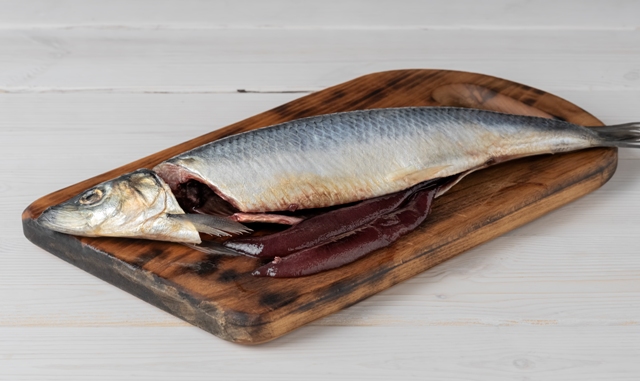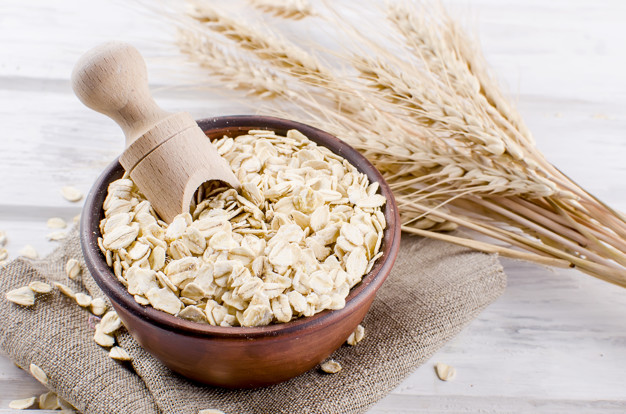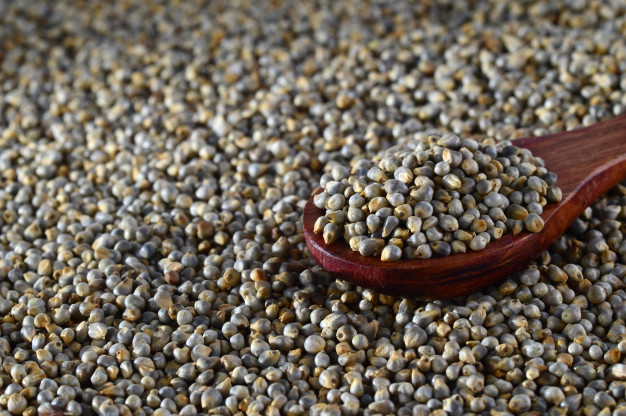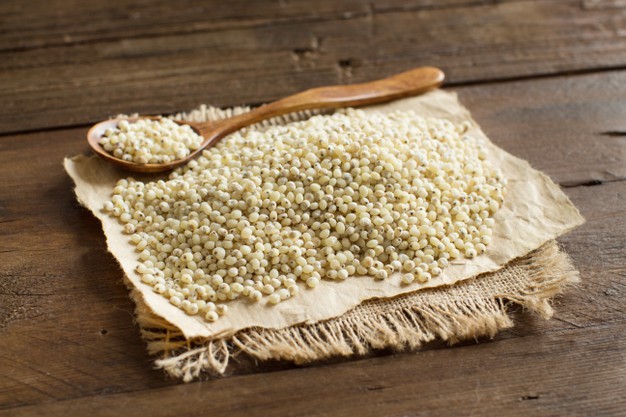Herring is basically a coastal pelagic fish and mainly found at the depth of 10 to 400m from the surface of the sea. It is primarily found in Atlantic and Pacific oceans. It is extremely nutritious and offers numerous health benefits.
Nutritional profile
Carbohydrate
- It contains lesser amount of carbohydrate thus it is considered as low glycemic food
- Being a low glycemic food it can be easily incorporated in the diet of diabetic patients
- It also contains lesser amount of fibre
Protein
- It is a good source of proteins of high biological value
- It is mainly rich in lean proteins
- It contains both essential and non essential amino acids
- It is especially rich in aspartic acid, glutamic acid, methionine, lysine, leucine, isoleucine, alanine, threonine, cysteine, arginine, histidine, phenyl alanine and valine
Fat
- It is considered as a healthy fat food
- It contains desirable amount of fat and contains both saturated and unsaturated fatty acids
- It contains relatively higher amount of unsaturated fat and composed of both monounsaturated and polyunsaturated fatty acids
- It is mainly rich in omega 3 fatty acid
- It contains cholesterol as well


Vitamins
- It contains several important vitamins that are accountable for performing numerous important biochemical functions of body
- It contains desirable amount of Vitamin A, which helps in promoting overall eye health and also helps in improving vision
- It also contains significant amount of Vitamin D that helps in strengthening overall skeletal system
- It is considered as a good source of Vitamin E too, that acts as antioxidant and exerts numerous nutraceutical activities
- It is a good source of B vitamins as well. It significantly rich in Vitamin B1, B2, B3, B5, B6, B9 and B12
- It contains too some extent of Vitamin C as well
Minerals
- It is loaded with numerous imperative trace elements, which are responsible for exhibiting various health benefits
- It contains desirable amount of calcium as well as phosphorus that help in healthy bone formation thus its consumption is believed to be very beneficial for obtaining a healthy skeletal system
- It contains sodium and potassium both. It is relatively higher in its potassium content than sodium. Both of these minerals play vital role in maintaining the electrolyte balance of the body. Whereas its potassium content is also accountable for promoting cardiac health and renal health
- It contains significant amount of zinc, which helps in improving overall cellular functions and also plays various important roles
- It is consisting of selenium, iodine, copper and iron too. All of these trace elements are extremely health worthy and perform numerous important biological functions of body

Health benefits
Role on preventing cellular damages
- It is packed with antioxidants, which play vital role in protecting every cell of the body from free radical induced oxidative damages as a result help in promoting overall cellular functions
- It helps to prevent oxidative stress too by neutralizing free radicals as well as reactive oxygen species, which ultimately helps in decreasing the risk of developing chronic diseases
- It is also associated with protecting various important biological substances of the body like lipids, DNA, RNA, proteins etc from oxidative damages as a result helps in sustaining their activity hence promotes wellbeing
Hypolipidemic activity
- Its consumption is very effective for decreasing total body fat percentage
- Its polyunsaturated fatty acid content especially omega 3 fatty acid content plays vital role in decreasing the concentration of bad cholesterol or LDL in body
- It is also related with decreasing the level of triglyceride and VLDL
- Whereas its unsaturated fatty acid content is also related with increasing the level of good cholesterol or HDL in body that provides a positive impact on health
- Individual who want to obtain a healthy lipid profile should include herring in their diet as it helps in maintaining a healthy ratio of LDL and HDL in body

Role on cardiac health
- It contains various important cardio friendly nutrients that help in promoting cardiac health as well as activity
- Its potassium content helps in preventing hypertension
- Its protein content helps in improving the growth and the functionality of cardiac muscle
- Its magnesium component helps in maintaining a healthy heart beat thus reduces the risk of developing arrhythmia
- Its lipid lowering activity is also responsible for decreasing the prevalence of atherosclerosis by inhibiting fat deposition within blood vessels, which ultimately reduces the susceptibility of blockage and coronary artery disease later in life
- Its consumption is also linked with reducing the prevalence of heart attacks and strokes

Role on nervous system
- Its consumption is closely related with reducing the risk of developing neurological disorders as it contains various nutrients that help in improving the health and functionality of both central and peripheral nervous system
- Its omega 3 fatty acid content especially EPA and DHA contents are accountable for normal brain functioning and play vital role in brain development throughout all stages of life
- Omega 3 fatty acid found in herring is also responsible for preserving the membrane of brain cells and also facilitates communication between brain cells
- Vitamin B6 present in herring is responsible for improving brain’s activity
- It also helps in improving cognitive ability as well as learning skills
- It helps in improve memory too

Role on gestational health
- Its consumption is extremely useful during gestational period as it contains many imperative nutrients that help to provide proper nourishment to the mother as well as to the foetus
- Proteins present in herring help in promoting the growth of maternal tissues. It plays vital role in the development of placenta, umbilical cord, amniotic fluid and breast
- Its Omega 3 fatty acid content and B vitamins play vital role in supporting the growth and development of foetal nervous system
- Iodine present in herring is also very useful for promoting the growth of foetal central nervous system
- Its folate content is accountable for decreasing the prevalence of birth defects
- Iron present in herring plays important role in reducing the risk of developing anaemia during gestation, which significantly reduces maternal morbidity and mortality rate
Other health benefits
- It helps in improving immunological responses of the body thus helps to lower the susceptibility of becoming ill
- It helps to reduce the prevalence of osteoporosis
- It is also associated with preventing joint swelling as a result helps in improving the symptoms of arthritis
- It helps to improve the symptom of anaemia as well
- It helps to prevent thyroid disorders too
- It is used as an important preventive measure for infertility as well. It’s Vitamin E and selenium content helps in fertility
- It helps to boost up overall metabolism of the body, which plays significant role in facilitating weight reduction
- Proteins present in herring act as building blocks of muscle thus its consumption helps in promoting overall muscular health

General consideration of using herring
- Being a perishable food it should be preserved well for preventing its spoilage. It is better to keep it in freezer as freezing helps to improve its self life
- It is healthy, tasty as well as affordable and does not contain too much mercury compared to other fish thus it is considered as safe for consumption

Source:
an Effective, A., Ackman, R.G. and Ratnayake, W.M.N., 2020. FISH OR FISH OILS AS SOURCES OF OMEGA-3 FATTY ACIDS. Omega-3 Fatty Acids in Health and Disease, p.215.
Egerton, S., Mannion, D., Culloty, S., Whooley, J., STANTON, C. and Ross, R.P., 2020. The proximate composition of three marine pelagic fish: blue whiting (Micromesistius poutassou), boarfish (Capros aper) and Atlantic herring (Clupea harengus).
Muhlhausler, B.S., 2021. Maternal Fish Intake and Infant Neurodevelopment: Causality or a Red Herring?. The Journal of Nutrition.
Pihlajamäki, M., Asikainen, A., Ignatius, S., Haapasaari, P. and Tuomisto, J.T., 2019. Forage fish as food: consumer perceptions on Baltic herring. Sustainability, 11(16), p.4298.
Pitcher, T.J., Lam, M.E., Kaiser, M., White, A.S.J. and Pakhomov, E., 2017. Hard of herring. Reflections of Canada: illuminating our opportunities and challenges at, 150, pp.112-119.









